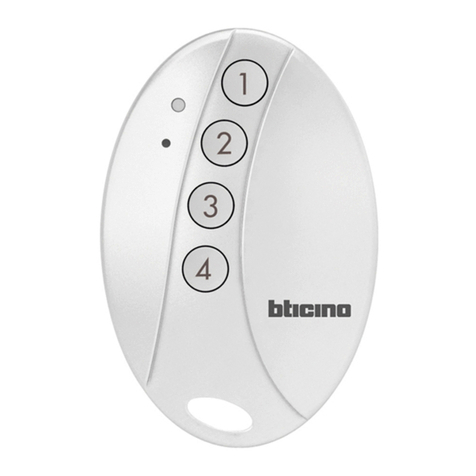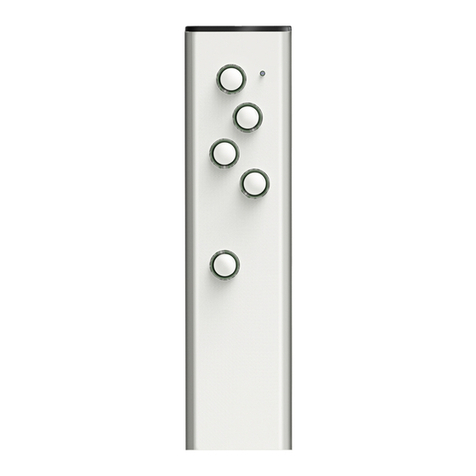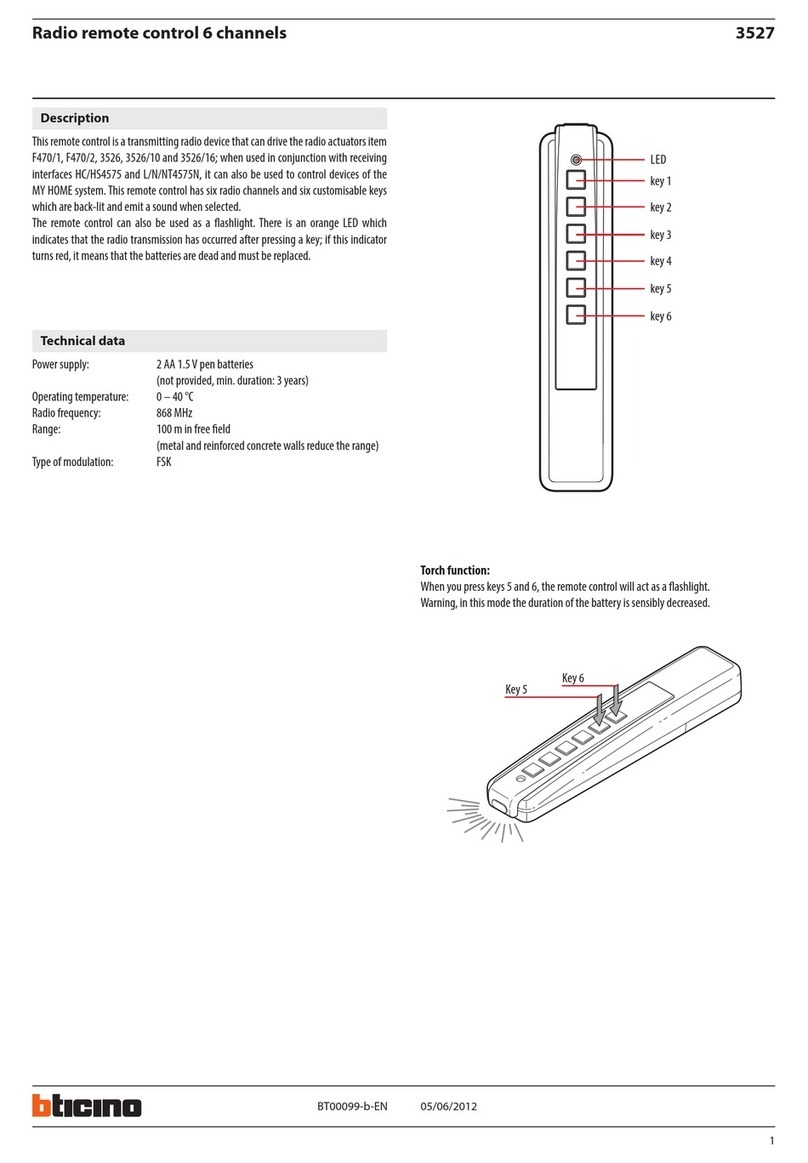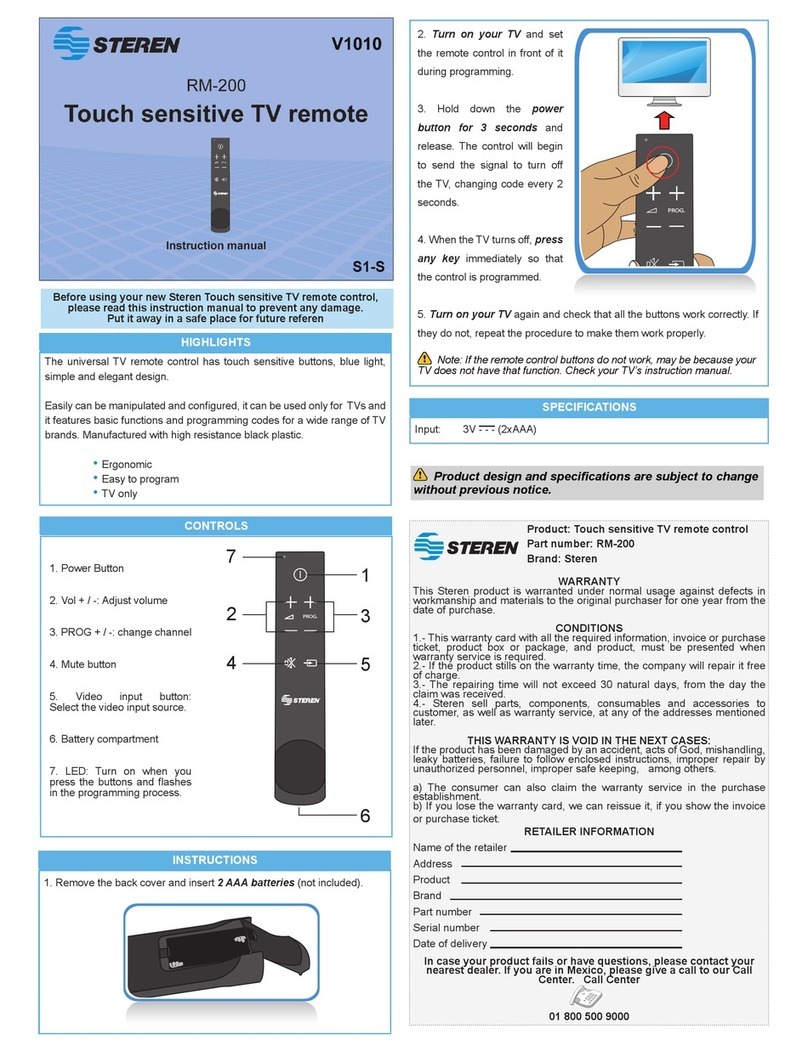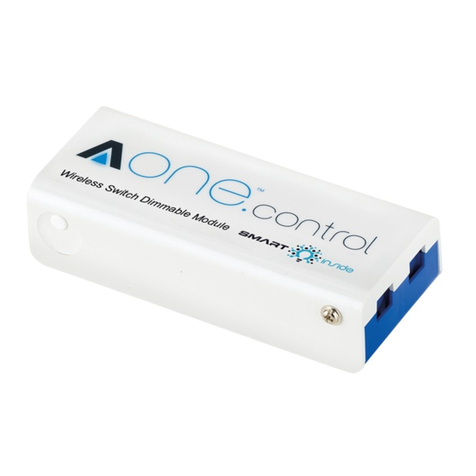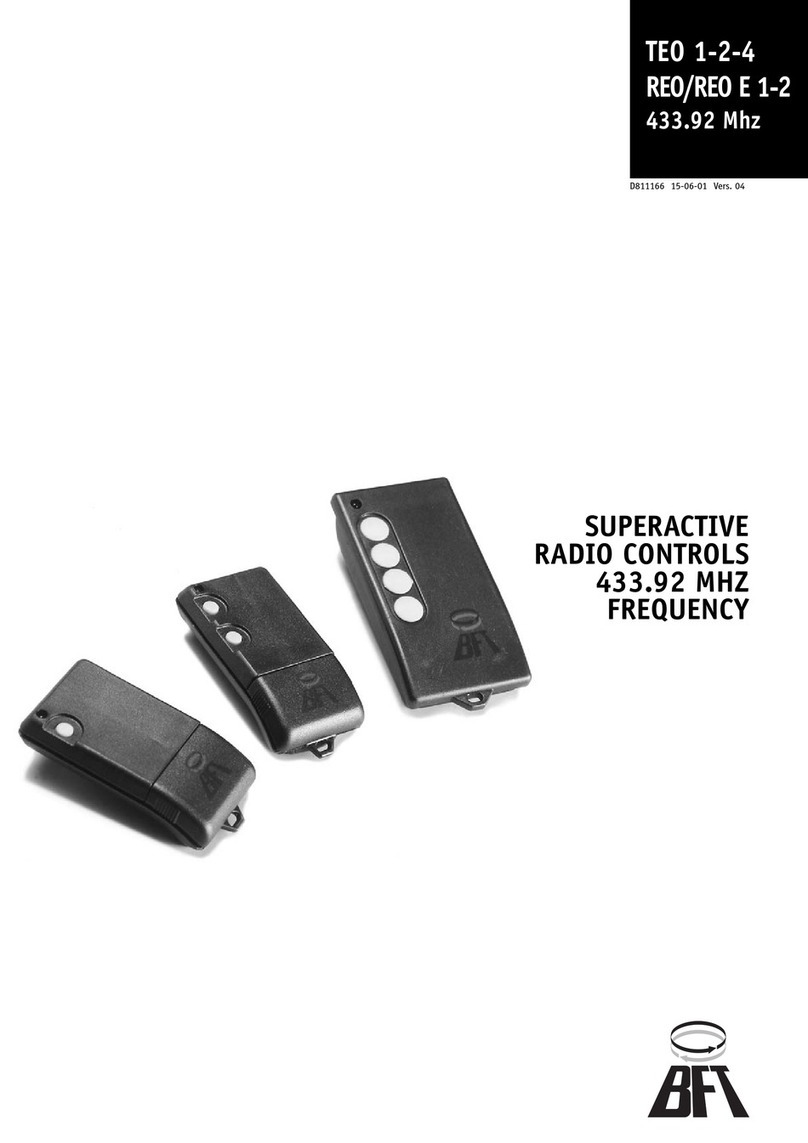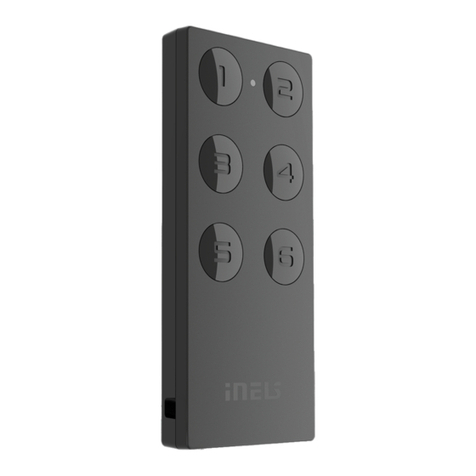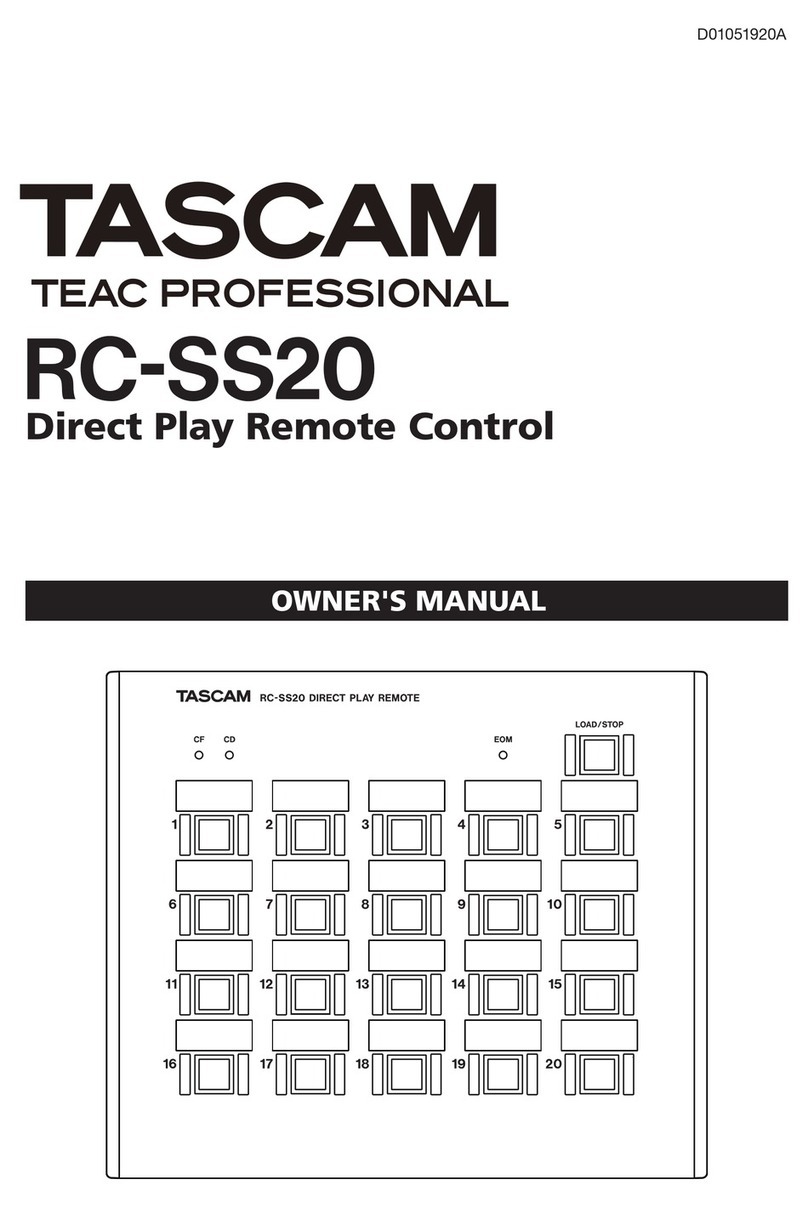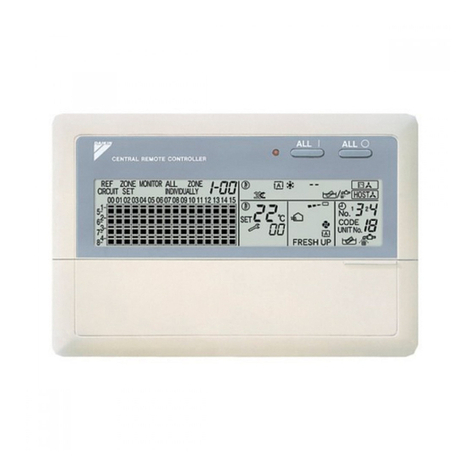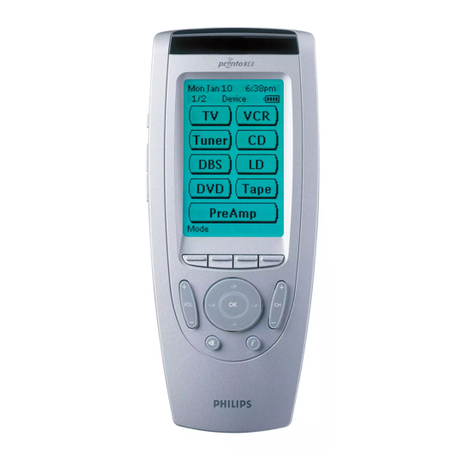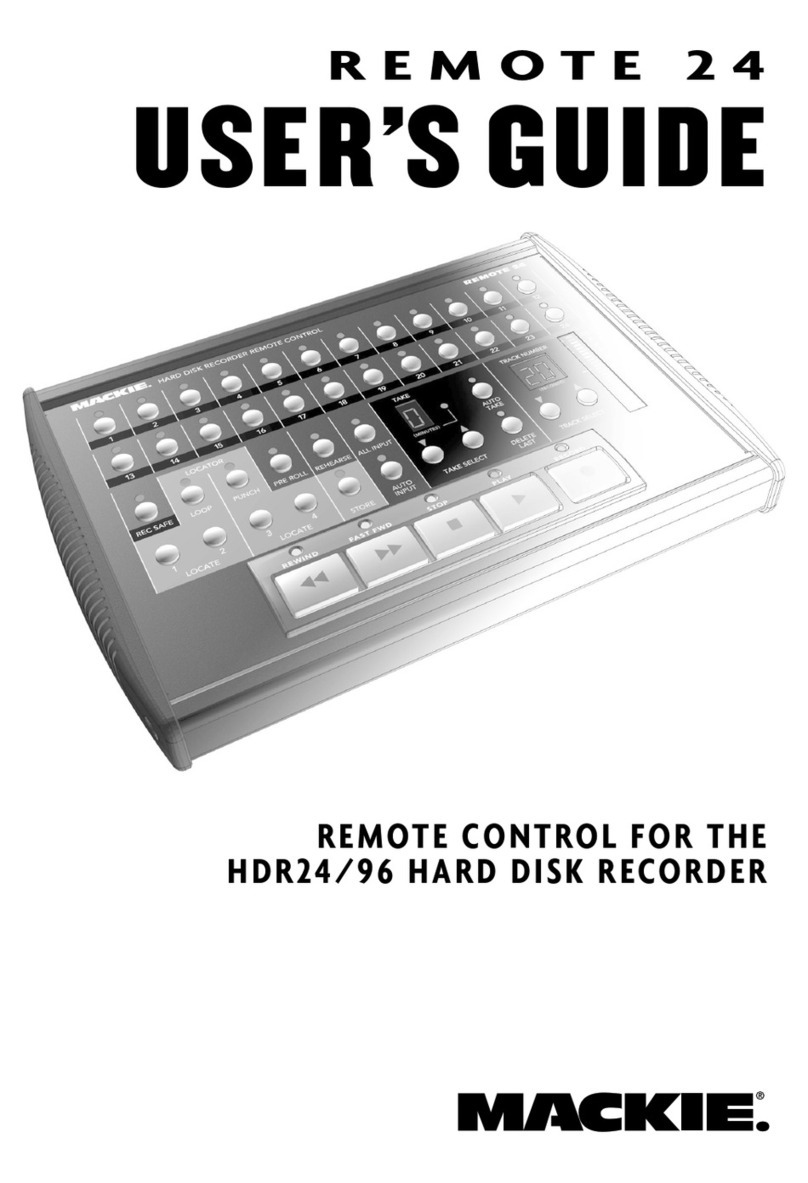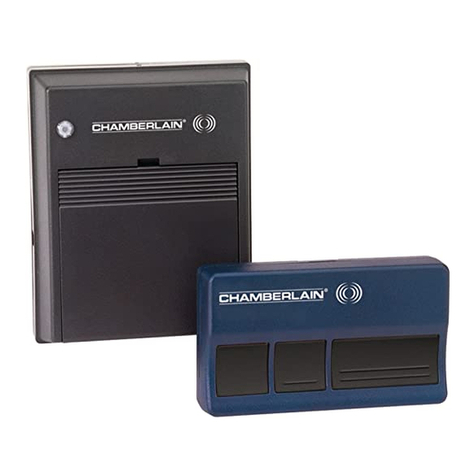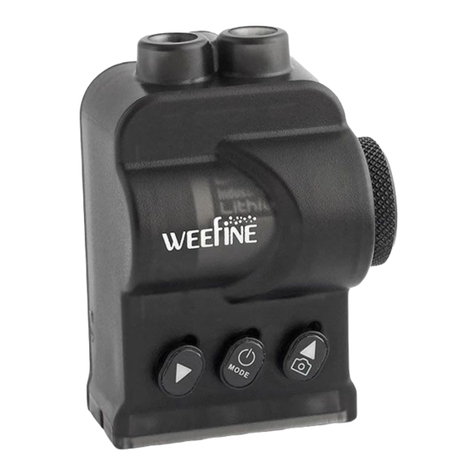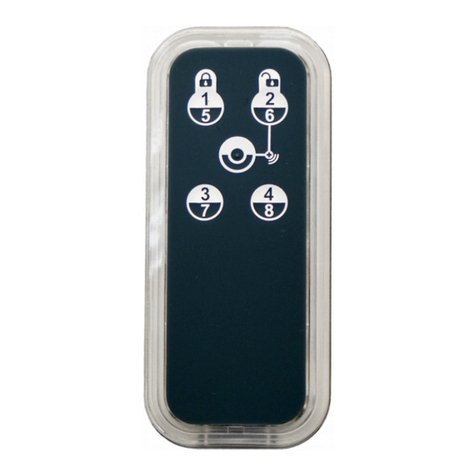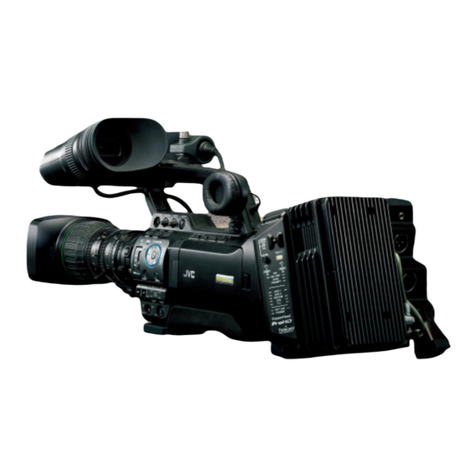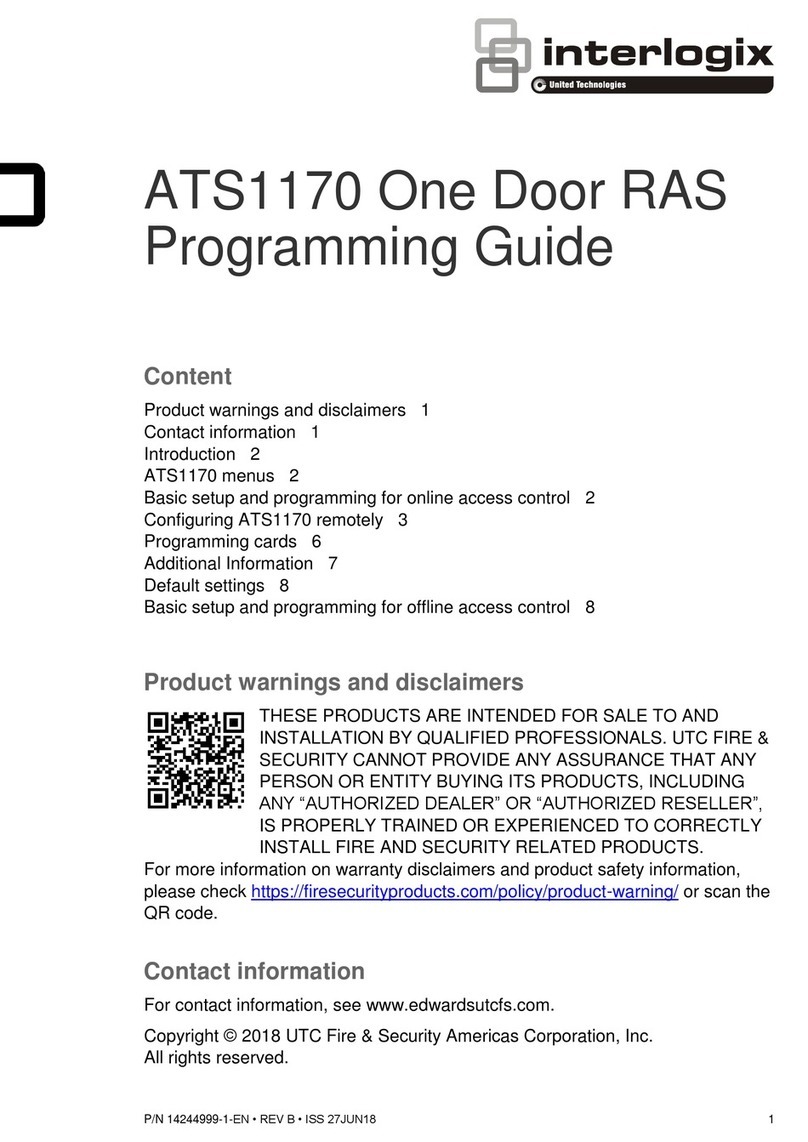Bticino 3527 User manual

PART. U0073C Istruzioni d’uso
Instructions for use 11/05-01 PC3527
1
3
Telecomando radio a 6 tasti
Questo telecomando è un apparecchio radio
trasmittente che consente di pilotare diretta-
mente gli attuatori radio art. F470/1, F470/2,
3526, 3526/10 e 3526/16.
Il telecomando ha sei canali radio ed è dotato
di sei tasti personalizzabili, retroilluminati e con
tono acustico di selezione. Il telecomando può
essere usato anche come torcia.
È presente un indicatore luminoso di colore
arancione che segnala, alla pressione di un
tasto, l’avvenuta trasmissione radio; se tale
indicatore diviene di colore rosso segnala che
le batterie del telecomando sono scariche e
vanno sostituite.
Inserimento delle batterie
2 batterie stilo 1,5V alkaline tipo AA. 2Funzione torcia
Premendo contemporaneamente i tasti 5 e 6,
il telecomando funge da torcia.
Tasto 1
Tasto 2
Tasto 3
Tasto 4
Tasto 5
Tasto 6
Indicatore
luminoso
Non utilizzare
batterie ricaricabili.
Tasto 6
Tasto 5
La durata delle batterie
diminuisce sensibilmente.
12
34
Arancione = trasmissione radio
Rosso = batterie scariche
4
Dati tecnici
Alimentazione: 2 batterie stilo 1,5V alkaline tipo AA non ricaricabili (a corredo)
Durata minima batterie: 3 anni (con le battarie fornite a corredo)
Frequenza radio: 868 MHz
Portata: 100 m in campo libero (pareti in metallo e cemento riducono la portata)
Tipo di modulazione: FSK
I

6
Configurazione
Il telecomando è dotato di sei tasti personalizzabili, retroilluminati e con tono acustico di selezione.
Il telecomando è fornito all’acquisto con la seguente configurazione di fabbrica: ogni tasto, quando premuto, si illumina, provoca
l’emissione di un segnale acustico ed esegue la commutazione ciclica dello stato del carico a lui associato (come illustrato qui sotto).
Switch 1
Switch 1 = SU
Illuminazione tasti = ON Alla pressione il tasto del telecomando si illumina.
Switch 1 = GIÙ
Illuminazione tasti = OFF Alla pressione il tasto del telecomando non si illumina.
Switch 2
Switch 2 = SU
Segnale acustico = ON
Alla pressione di un tasto viene emesso un segnale
acustico.
Switch 2 = GIÙ
Segnale acustico = OFF
Alla pressione di un tasto non viene emesso alcun
segnale acustico.
Switch 3
Switch 3 = SU
Funzionamento = CICLICO (*)
I tasti vengono gestiti singolarmente in modalità di
funzionamento ciclica (ON/OFF).
Switch 3 = GIÙ
Funzionamento = SINGOLA FUNZIONE (*)
I tasti vengono gestiti automaticamente a coppie
1-2, 3-4, 5-6 (es.: tasto 1 = ON, tasto 2 = OFF).
Switch 4
Switch 4 = SU
Modalità programmazione (**)
Terminata la programmazione riportare lo switch in
posizione GIÙ (modalità di funzionamento normale).
Switch 4 = GIÙ
Modalità di funzionamento normale
1234
1234
123 4
123 4
1 2 34
1 2 34
1234
1234
1 2 3 4
Personalizzazione dei tasti
È possibile personalizzare i tasti del telecomando mediante
le etichette fornite a corredo.
1 - sganciare la parte superiore del telecomando aiutandosi
con un cacciavite
2 - rimuovere la parte superiore del telecomando
3 - estrarre i 6 copritasti
4 - posizionare sui tasti le etichette a corredo
5 - riposizionare i copritasti
6 - richiudere il telecomando
5
5
2
3
4
Punti di
ancoraggio
1
È possibile modificare la configurazione di fabbrica cambiando
la posizione degli switch di configurazione come indicato nella
tabella seguente.
Per accedere agli switch rimuovere la parte superiore del
telecomando.
Stato del
carico
Stato del
carico
Stato del
carico
Stato del
carico
OFF pressione
tasto ☛ON pressione
tasto ☛OFF pressione
tasto ☛ON

(**) In modalità programmazione è possibile:
Scegliere il livello del segnale acustico tra i due disponibili
1 - Tenere premuti contemporaneamente i tasti 1 e 3, trascorsi 2 secondi i tasti 1 e 2 si illuminano.
2 - Premere uno dei tasti illuminati per ascoltare il segnale acustico ad esso associato (tasto 1 livello più alto).
3 - Tenere premuto il tasto corrispondente al livello desiderato per un tempo superiore a 2 secondi.
4 - La memorizzazione del livello viene confermata con l’emissione del segnale acustico ed il lampeggio del tasto.
Associare ad una o più coppie di tasti i comandi relativi alla gestione tapparelle
1 - Tenere premuti contemporaneamente i tasti della coppia interessata (1-2, 3-4, 5-6) per un tempo superiore a 2 secondi.
2 - La conferma dell’avvenuta programmazione viene data dal lampeggio dei tasti associati.
Riportare una coppia di tasti associata alla gestione tapparelle in modalità luci
1 - Tenere premuti contemporaneamente i tasti della coppia associata alla gestione tapparelle fino al lampeggio dei tasti.
2 - La conferma dell’avvenuta programmazione viene data dal lampeggio dei tasti associati.
Riportare tutti i tasti in modalità luci
1- Tenere premuti contemporaneamente i tasti 1, 2, 5 e 6 per un tempo superiore a 2 secondi.
2 - La conferma dell’avvenuto “reset” è data dal lampeggio di tutti i sei tasti.
7
ON/OFF (carico 1)
ON/OFF (carico 2)
ON/OFF (carico 3)
ON/OFF (carico 4)
ON/OFF (carico 5)
ON/OFF (carico 6)
(*) La figura seguente mostra i funzionamenti CICLICO ed a SINGOLA FUNZIONE,
selezionabili mediante lo switch 3.
ON (carico 1)
OFF (carico 1)
ON (carico 2)
OFF (carico 2)
ON (carico 3)
OFF (carico 3)
FUNZIONAMENTO CICLICO FUNZIONAMENTO SINGOLA FUNZIONE
È necessario che ogni attuatore radio sia programmato da tutti i tasti del telecomando che lo pilotano
(ad esempio se ai tasti 1-2 è associata la modalità tapparelle e quindi all’1 il SU e al 2 il GIÙ, occorre
effettuare sull’attuatore la procedura di programmazione sia per il tasto 1 sia per il tasto 2).

Richiamo delle principali funzioni del telecomando
Le principali funzioni del telecomando possono essere richiamate anche da una persona diversamente abile tramite il segnale
proveniente da un sensore esterno (dispositivi di comando che consentono di recuperare l’abilità motoria residua di una persona
diversamente abile).
SCANSIONE TASTI - il primo segnale proveniente dal sensore esterno avvia la scansione dei tasti del telecomando; il tasto a cui
è giunta la scansione è riconoscibile dal segnale luminoso e/o acustico.
SELEZIONE TASTO - il secondo segnale proveniente dal sensore ferma la scansione al tasto selezionato.
ATTIVAZIONE COMANDO - il terzo segnale proveniente dal sensore equivale alla pressione standard del tasto selezionato.
In caso di pressione breve, il tasto selezionato si intende premuto e rilasciato; se la pressione risulta invece prolungata, il
telecomando attende un quarto segnale proveniente dal sensore che sarà interpretato come rilascio del tasto. Il tempo fra il terzo
e il quarto segnale viene interpretato come una pressione prolungata. Se il tasto selezionato è associato ad una tapparella, alla
pressione prolungata viene associato direttamente il comando di SU/GIÙ.
La chiusura del segnale proveniente dal sensore per un tempo maggiore di 5 secondi provoca l’invio di una segnalazione con un
particolare codice ben diverso da quello inviato con i tasti convenzionali. In questo modo, se a questo segnale è stato associato
un attuatore radio che attiva una sirena, si può generare un segnale di allarme.
Configurazione del telecomando
In modalità programmazione è possibile modificare il tempo di scansione di ogni singolo tasto.
Il telecomando viene fornito all’acquisto con un tempo di scansione pari a 1 secondo.
1 - Posizionare lo switch 4 in modalità programmazione (SU).
2 - Premere contemporaneamente i tasti 1 e 6 per un tempo superiore a 2 secondi; si illuminano i primi quattro tasti.
3 - Premere uno dei tasti illuminati per effettuare una scansione di prova del tempo ad esso associato.
I tempi di scansione sono i seguenti:
Tasto 1 = 2 secondi
Tasto 2 = 1 secondo
Tasto 3 = 0,5 secondi
Tasto 4 = 0,3 secondi
4 - Tenere premuto il tasto corrispondente al tempo di scansione desiderato per un tempo superiore a 2 secondi.
5 - La conferma dell’avvenuta programmazione viene data dal lampeggio del tasto premuto.
6 - Posizionare lo switch 4 in modalità funzionamento normale (GIÙ).
8
Funzioni ulteriori del telecomando (per utilizzo da parte di persone diversamente abili)
Il telecomando radio è dotato di:
- ingresso jack mono standard da 3,5mm per il collegamento
ad un sensore per persone diversamente abili;
- attacco a vite per il fissaggio ad una carrozzella
oppure alla sponda di un letto.
Ingresso
jack
Attacco a vite
I sensori esterni utilizzati devono rappresentare, da
un punto di vista elettrico, un contatto in chiusura.
Se l’attivazione comando (terza chiusura) non avviene entro tre volte
il tempo selezionato per la scansione, la scansione stessa riparte.

9
11
Radio remote control with 6 keys
This radio control is a transmitting radio device
which can directly drive radio actuators items
F470/1, F470/2, 3526, 3526/10 and 3526/16.
The radio control has six radio channels and
comes with six backlit keys which can be
customised. It has an audible selection tone
and can also be used as a torch.
It has an orange luminous indicator which
signals, when a key is pressed, that the radio
transmission is taking place. If this indicator
turns red it signals that the remote control
batteries are flat and should be replaced.
Inserting the batteries
2 AA 1.5V alkaline pen batteries.
10
Torch function
On pressing keys 5 and 6 simultaneously the
remote control acts as a torch.
Key 1
Key 2
Key 3
Key 4
Key 5
Key 6
Luminous
indicator
Do not use
rechargeable batteries.
Key 6
Key 5
The batteries will
not last as long.
12
34
Orange = radio transmission
Red = flat batteries
12
Technical data
Power supply: 2 non-rechargeable AA 1.5V alkaline pen batteries (supplied)
Minimum battery lifetime: 3 years (with the batteries supplied)
Radio frequency: 868 MHz
Range: 100 m in free space (metal and cement walls reduce the range)
Type of modulation: FSK
GB

14
Configuration
The remote control has six keys which can be customised. They are backlit and have an audible selection tone.
When purchased the remote control has the following factory configuration: each key when pressed lights up, emits an audible
signal and cyclically switches the load state associated with it (as shown below).
Switch 1
Switch 1 = UP
Key lighting = ON When pressed the remote control key lights up.
Switch 1 = DOWN
Key lighting = OFF
When pressed the remote control key does
not light up.
Switch 2
Switch 2 = UP
Audible signal = ON When a key is pressed an audible signal sounds.
Switch 2 = DOWN
Audible signal = OFF When a key is pressed no audible signal sounds.
Switch 3
Switch 3 = UP
Operation = CYCLICAL (*)
The keys are managed individually in cyclical
operation mode (ON/OFF).
Switch 3 = DOWN
Operation = SINGLE FUNCTION (*)
The keys are managed automatically in pairs
1-2, 3-4, 5-6 (e.g.: key 1 = ON, key 2 = OFF).
Switch 4
Switch 4 = UP
Programming mode (**)
When the programming is finished return the switch
to the DOWN position (normal mode of operation).
Switch 4 = DOWN
Normal mode of operation
1234
1234
123 4
123 4
1 2 34
1 2 34
1234
1234
1 2 3 4
Customising the keys
The remote control keys can be customised using the labels
supplied.
1 - use a screwdriver to unhook the upper part of the remote
control
2 - remove the upper part of the remote control
3 - remove the 6 key covers
4 - position the labels supplied on the keys
5 - reposition the key covers
6 - close the remote control again
13
5
2
3
4
Anchoring
points
1
The factory configuration can be modified by changing the
position of the configuration switches as shown in the table
below.
To access the switches remove the upper part of the remote
control.
Load
state
Load
state
Load
state
Load
state
OFF press
key ☛ON press
key ☛OFF press
key ☛ON

(**) In programming mode one can:
Select the level of the audible signal from the two available
1 - Keep keys 1 and 3 pressed simultaneously. After 2 seconds keys 1 and 2 light up.
2 - Press one of the lit keys to hear the audible signal associated with it (key 1 louder level).
3 - Press the key associated with the level required for more than 2 seconds.
4 - The audible signal sounds and the key flashes, confirming that the level is saved.
Associate the commands associated with rolling shutter management with one or more pairs of keys
1 - Keep the keys of the pair involved (1-2, 3-4, 5-6) pressed simultaneously for more than 2 seconds.
2 - The associated keys flash to confirm that the programming has taken place.
Return a pair of keys associated with rolling shutter management to light mode
1 - Keep the keys of the pair associated with rolling shutter management pressed simultaneously until the keys flash.
2 - The associated keys flash to confirm that the programming has taken place.
Return all the keys to light mode
1 - Keep keys 1, 2, 5 and 6 pressed simultaneously for more than 2 seconds.
2 - All six keys flash to confirm the reset.
15
ON/OFF (load 1)
ON/OFF (load 2)
ON/OFF (load 3)
ON/OFF (load 4)
ON/OFF (load 5)
ON/OFF (load 6)
(*) The following figure shows the CYCLICAL and SINGLE FUNCTION operations,
which can be selected by means of switch 3.
ON (load 1)
OFF (load 1)
ON (load 2)
OFF (load 2)
ON (load 3)
OFF (load 3)
CYCLICAL OPERATION SINGLE-FUNCTION OPERATION
Each radio actuator must be programmed by all the remote control keys which drive it (e.g. if
the rolling shutter mode is associated to keys 1-2, i.e. UP to 1 and DOWN to 2, the programming
procedure must be performed on the actuator for both key 1 and key 2).

Calling the main remote control functions
A disabled person can also call the main radio control functions by means of the signal from an external sensor (control devices
which can make use of the residual motor ability of a disabled person).
KEY SCANNING - the first signal from the external sensor starts scanning the remote control keys; the key which the scanning
has reached can be recognised by the luminous and/or audible signal.
KEY SELECTION - the second signal from the sensor stops the scanning at the key selected.
COMMAND ACTUATION - the third signal from the sensor is the same as the standard pressing of the key selected. If the key is
pressed quickly, it is understood as pressed and released; if instead it is pressed for longer, the remote control waits for a fourth
signal from the sensor which will be interpreted as releasing the key. The time between the third and fourth signal is interpreted
as a long press. If the key selected is associated with a rolling shutter, the UP/DOWN command is directly associated with the
long press..
If the signal from the sensor is closed for longer than 5 seconds a signal is sent with a special code which is very different from
that sent with the conventional keys. In this way, if a radio actuator which activates a siren is associated with this signal, an alarm
signal can be generated..
Configurating the remote control
In programming mode the scanning time of each key can be modified.
When purchased the remote control is supplied with a scanning time of 1 second.
1 - Position switch 4 in programming mode (UP).
2 - Press keys 1 and 6 at the same time for more than 2 seconds; the first four keys light up.
3 - Press one of the lit keys for a test scan of the time associated with it.
The scanning times are the following:
Key 1 = 2 seconds
Key 2 = 1 second
Key 3 = 0.5 seconds
Key 4 = 0.3 seconds
4 - Keep the key corresponding to the scanning time required pressed for more than 2 seconds.
5 - The pressed key flashes to confirm that the programming has taken place.
6 - Position switch 4 in normal mode of operation (DOWN).
16
Further remote control functions (for use by the disabled)
The radio remote control is fitted with:
- standard 3.5 mm mono jack input for connection
to a sensor for disabled people;
- screw connection for fastening to a wheelchair
or to the edge of a bed.
Jack
input
Screw
connection
The external sensors used must represent,
from an electrical point of view, a closed contact.
If the command (third closing) is not activated within three times
the time selected for the scanning, the scanning itself starts again.
Table of contents
Languages:
Other Bticino Remote Control manuals
